Examples of the different mer races as shown here.
Mer (also called Elvenkind or just Elves, or rarely Elfs) as a collective term, encompasses beings of the elven race in Tamrielic culture. There is no difference between the word for a male and female mer which is different for men as they use the words 'men' and 'women'.
Drastically different culturally and physiologically from men and beastfolk, Mer are genetically capable of interbreeding with the former, and while rumors of the latter exist, they are unproven.
Mer come in an array of colors, from dark grey, to light green to pale yellow. Of the mer race, there are multiple subraces currently existing on the Tamrielic continent. These include, Altmer, Bosmer, Dunmer, Orsimer, Dwemer, Ayleid and Falmer. The Aldmer are an extinct mer race from which these mer sprang. There are a few other mer, such as the Maormer, that are believed to be related to these races of mer as well.
Etymology and usage
The term "Mer" can have one of two meanings:
- A group of related races of sentient beings which developed from the Ehlnofey.
- A member of one of the aforementioned elven races (Though exceptions do exist, such as the Ayleids & Bretons).
Mer is the word used in the ancient Aldmeri tongue to mean "person" or "us". The term is analogous to the way humans use the word man. Speakers of the Imperial tongue often substitute "elf" for "mer", especially in adjective form, as "elven" seems to sound better than the more correct term, "meri". Most mer seem to accept "elf" as a suitable synonym, though they still usually refer to each other as "mer".
When referring to individual members of the elven races, mer can be both singular (I've seen that mer in the Arena.) and plural (A dozen well-armed mer just went into that house!) When used in combination with other words from the Aldmeri tongue, it simply means "a type of people", and is translated into common as "elf", or sometimes as "ones" (e.g., "first ones").
Origins
The first mer came from the continent of Aldmeris. The Aldmer were the first of all the mer to arrive to Tamriel as they were the first of all mer to exist.
Generally speaking, the mer believe themselves to be direct descendants of the Aedra, having been tricked by Lorkhan into giving up their immortality to create the world. Their opinions on their mortality differs from race to race, but none consider it a "gift" in the way humans do. Rather, opinions range from lamenting the loss of their birthright, to enduring the suffering as a test of character.
Though all modern-day mer descend from a single proto-race, they have diversified significantly in the thousands of years since the Mythic Era, into various mer races.
Lifespan
- "Humans are all short-lived. Ephemeral, as we of the Elder Races say. They come and go as the seasons -- but the families of the powerful ones live on for a time. Their cities and dominions bloom like spring flowers, only to wither and die in the summer sun. But the Elves endure. We are as a year to their hour, a decade to their day."
- ―Drelliane to Queen Barenziah
Mer are capable of living for a thousand years, although few ever actually live that long due to disease and violence.[1] Altmer are far more resistant to disease than the other races of Tamriel, due to their sublime physical natures and often being gifted in the arcane arts.[2] The Altmer were also taught how to naturally live another hundred years by Phynaster, the Hero-god of the Summerset Isles.[3] At the time of the publication of the Pocket Guide to the Empire, Third Edition in 3E 432, many living Altmer still remembered Tiber Septim's conquest of Summerset, thus putting them at an age of over 400 years.[4] According to Uupse Fyr, there may be some Altmer/Aldmer on Summerset Isles who are over 4000 years old. Nurelion, an Altmer alchemist, was known to have died from old age.
The earliest mention of the Aldmer Iachesis, Rite Master of the Psijics, is from 1E 20,[5] and the latest exact date with mention of Iachesis is 1E 2920, when he met with Sotha Sil and Almalexia on Artaeum.[6] This means that Iachesis was over 2900 years old before his disappearance.
According to Alfe Fyr, the Dunmer Divayth Fyr is a "4000-year-old wizard." Uupse Fyr claims that "he's probably the oldest and most powerful wizard alive. Not counting liches, or divine sorcerers like Vivec". Divayth Fyr has likely extended his life for over 4000 years using magic.
The Orsimer mage and librarian, Urag gro-Shub, states that if he didn't take his work seriously, most books in The Arcanaeum "would've been burned to ashes or dissolved to nothing before the Third Era". This puts him at an age of over 200 years.
The Dunmeri Councilor of Raven Rock, Lleril Morvayn, succeeded his mother as Councilor of the town in 4E65, and his rule continues to the present. If the Dunmeri aging process is relatable to that of Men, his complexion suggests that he is approximately of late-middle-age. His assension was over 130 years prior to the events of The Elder Scrolls V: Dragonborn, so a lower approximation of his age may be placed reasonably at 150-160 years old.
Queen Mother Barenziah in The Elder Scrolls III: Tribunal is approximately 432 years old, having been born in 2E 893. In comparison to humans she looks to be in her late 60s, meaning she is in her elder years.
Knight-Paladin Gelebor is a Snow Elf who has lived over 4,000 years. Whether this is from the natural lifespan of his subspecies, a direct life extension from Auri-El or a life extension done by his own knowledge is unknown. All other known Snow Elves are deceased so how long they may live cannot be determined, though the snow elves known as Falmer are still alive when they were blinded by the Dwemer after the Atmorans attack, so it's safe to assume that their life span is long. Arch-Curate Vyrthur is also a Snow Elf known to have lived as long as Gelebor, but since he is a vampire it may be the cause of his long lifespan.
Physiology
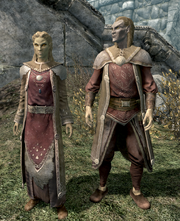
A female Altmer and male Altmer
It is very easy to tell mer from men based on appearance, as mer are less muscular than most men, but have a greater variety of skin tones. Another easily noticeable feature of mer is that they have pointy ears that men do not have (apart from the odd Breton, whom only have very slightly pointed ears). Furthermore, most mer, even females, are taller than most men. There are exceptions to this as the Orsimer are around the same size as men and the Bosmer, who are shorter.
Another small difference worth mentioning is that mer rely heavily on magical warfare as they have a higher affinity for nature and magic, where Men tend to be less potent magically. The only exception to this of course are the Bretons as they are a mix of both the Altmer and the Nedes.
Tamrielic elven races
Most of the present-day elves live on the continent of Tamriel. For the most part, these elven races have integrated successfully with the Cyrodilic Empire, though some racial tension still exists in parts of the continent.
Altmer
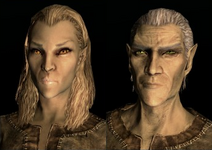
A male and female Altmer in Skyrim.
- Main article: Altmer
Altmer, in the ancient Aldmeri tongue, means "High One", though the Altmer themselves would say "Cultured One". They are a race that hails from the mysterious Summerset Isle. The Altmer consider themselves the most civilized people on Tamriel, a statement which is difficult to refute outright. Of the modern elven races, Altmer are likely the closest in appearance and behavior to the ancient Aldmer, due to a conscious effort of selective breeding. Of particular interest is the fact that two of the members of the Dunmer Tribunal, Vivec and Almalexia, appear much more like Altmer than Dunmer. This likely means the Chimer resembled Altmer before the change, and these two were able to maintain that appearance through their stolen divine power. According to the Pocket Guide to the Empire, First Edition, selective breeding and infanticide was practiced in order to help purify their race, though this information may be biased against Altmer.
Bosmer
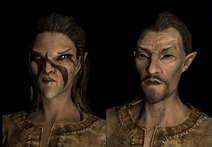
Bosmer in Skyrim.
- Main article: Bosmer
Bosmer translates most directly into Imperial speech as Tree-Sap People, though they are much more commonly called Wood Elves. As the name suggests, the Bosmer inhabit the wooded areas in southwest Tamriel, particularly the Valenwood. Bosmer as a group are less haughty and cultured than Altmer, and more attuned to nature. They are particularly well suited to hunting and ranging activities in the deep forests.
Dunmer
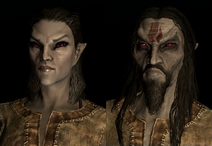
Dunmer in Skyrim.
- Main article: Dunmer
The Dunmer, or Dark Elves, are a somewhat isolationist race of mer populating the northeast portion of the continent, Morrowind, and in particular the huge island of Vvardenfell. They are ancient enemies of the Nords, who often try to invade their homeland. Dunmer culture is quite different from that of other mer, most notably in their rejection of the Aedra and worship of Daedra or their living gods, The Tribunal. The word "dark" ostensibly describes the ash-colored skin, but can also be interpreted as gloomy or sinister.
According to legend, the Dunmer are the remnants of the elven race the Chimer, changed into Dunmer by the Daedric Prince Azura as punishment for the crimes of their leaders. Dunmer culture is much more cutthroat and aggressive than other Tamrielic cultures. Slavery was legal until just a few years prior to the end of the Third Era, and there is still an active, legally sanctioned assassins guild (the Morag Tong) which is permitted to kill with impunity under certain circumstances.
Orsimer
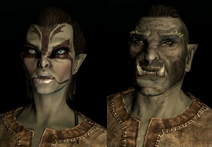
Orsimer in Skyrim
- Main article: Orsimer
The closest translation available for Orsimer is Pariah Ones (c.f. Orsinium, "Pariah City"). The Orsimer, like the Dwemer and Chimer, were originally an offshoot of the Aldmer, who chiefly worshiped the Aedra Trinimac. When the Daedric Prince Boethiah was trying to convince the future Chimer to abandon their Aedra worship and follow him, his first act was to "eat" Trinimac (how figurative this was is up for debate), and assume his form. When he was finished, he left Trinimac behind, who then changed into a Daedric Prince, Malacath. Trinimac's Orsimer followers were also changed, into the basic form seen today.
The Orcish culture and society revolves around tightly knit tribes. Every Orc has a specific job and is obligated to perform it. Every man, woman, and child in the fort or Stronghold is also trained from birth to defend it. Only the chiefs are allowed to have wives, and due to this, they often have several. This method is to ensure that the strongest Orc becomes chief, contributing his genes to the next generation of orcs who in theory should be stronger than the last. Orcs in strongholds follow their own law called "The Code of Malacath." The will of Malacath is clarified by the stronghold's resident wise woman. The rules of the Code are simple: don't kill, don't steal, and don't attack people without reason. They do not have jails; instead, offenders are forced to pay a "blood price," in which the criminal bleeds until the victim is satisfied. In cases where the victim was murdered, the chief is consulted to convey an appropriate sentence.
The Orsimer, or orcs, are far larger in size than any other mer ethnicity. Although shorter than the Altmer, the Orsimer have a heavier build and possess great upper-body strength. This results in a quite masculine, or even beast-like appearance. This is likely due to their brutish and savage warrior life style, a result of the conditioning they put upon themselves to follow the ways of Malacath.
Ancient elven races
Aldmer
Vanus Galerion, the last known Aldmer.
The Aldmer, or First Ones, were the ancestral Elven race, and are the direct descendants of the Ehlnofey (besides the Hist, the only ancient race of Nirn to survive its early days). Modern scholars believe that all of the Ehlnofey on Tamriel became the Aldmer, while those on the other three continents became men (Nords, Redguard, and Tsaesci).
By the time recorded history begins, the Aldmer had diverged into various other races. The Altmer are believed to be the closest to original Aldmer in look and behavior. The Daedric Princes occasionally interfered in Aldmeri life to create other derivatives (notably the Dunmer and Orcs). The term Aldmeri is sometimes used, incorrectly, to refer to all elves, especially by Imperial speakers who are unaware of the history of the race.
The last known Aldmer was Vanus Galerion, who died sometime in the 2nd era.
Ayleid
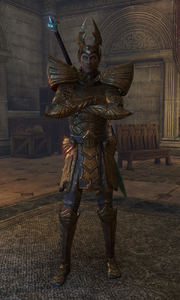
King Laloriaran Dynar, an Ayleid.
- Main article: Ayleid
The Ayleid, also known as the Wild Elves or Heartland High Elves, were an offshoot of the Aldmer that inhabited the highlands of central Tamriel. They lived primarily in what is now northern Cyrodiil, during the Mythic and early First Eras. Much like the Dwemer in Morrowind, Ayleid culture is known primarily for the complex and intricate architecture they created, much of which still exists. Underground Ayleid ruins still contain remnants of their magic (including the increasingly rare Varla Stones), as well as the occasional artifacts. The Ayleid were also responsible for building the White Gold Tower, which today stands at the heart of the Imperial City. After a revolt by their human slaves approximately 200 years into the First Era, the bulk of the Ayleid were eventually driven south, to the Summerset Isles, where they were assimilated into the Altmer. While civilized mer claiming to be Ayleid still appear in Tamrielic history until well into the Second Era, most scholars believe the race has either died out, or at best consists of scattered, primitive tribes hiding deep within the Cyrodilic forests.
The exact translation of Ayleid is not certain, as they spoke a language which has been mostly lost to history. A traditional Bosmer poem, "Meh Ayleidon"[source?], means "One Thousand Benefits of Hiding", so Ayleid may translate into Hidden Ones.
Chimer
Almalexia, a Chimer.
- Main article: Chimer
The Chimer, or Changed Ones, were a splinter group of Aldmer who rejected almost all of the traditional religious teachings of their parent race. These mer instead chose to worship Daedric Princes, specifically Azura, Boethiah and Mephala, and place a much stronger emphasis on ancestor spirit worship. The three Daedra convinced the Chimer to reject Aedra worship as a lie, and look down on their Aldmeri brothers as weak. The Chimer were led, by a mer prophet named Veloth, from the Summerset Isles to the large island to the east of mainland Tamriel, which they initially named Velothi, but was soon known as Resdayn. The Chimer lived in Resdayn with another group of elves, the Dwemer, in alternating periods of peace and warfare, with both the Dwemer and the Nords to the north, until the middle of the Second Era. At that point, a catastrophic battle between the two elvish races caused the entire Chimer race to change, into the modern day Dunmer, and their homeland became known as Morrowind.
Dwemer
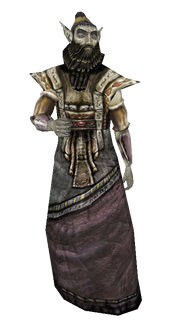
An Ancient Dwemer
- Main article: Dwemer
The Dwemer, which translates roughly as Deep Ones, were a scientifically advanced group of mer who rejected much of the traditional Aldmer teachings to emphasize science and magecraft over god worship. Their name derives from their habit of building vast structures, both as dwellings and as workshops, deep in the mountains of Vvardenfell. The Dwemer, along with the Chimer, were traditional enemies of the Nords, and often were at odds with the Chimer themselves. At some point, possibly after their disappearance near the end of the Second Era, their name was corrupted in the Imperial speech into "dwarf", although the Dwemer did not appear to resemble traditional dwarves in any meaningful way. They were basically the same size and shape as any other mer of the time, though unlike other mer, were often depicted with full beards. They are believed to be the only race of mer on Tamriel that did not descend from the original Aldmeri inhabitants, but instead branched off from the Aldmer before their arrival and immigrated to Tamriel independently.
The only known Dwemer still alive on Tamriel is Yagrum Bagarn, and due to an infection with the deforming corprus disease, his current appearance is quite different from that of a healthy adult Dwemer. He did not dissapear as he was in the realm of Oblivion at the time.
Snow Elves
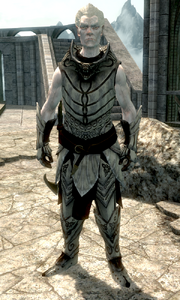
Knight-Paladin Gelebor, the last known Snow Elf
- Main article: Snow Elf
The Snow Elves were a race of Mer who inhabited Skyrim long before the Nords. It is commonly believed that centuries of underground living and Dwemer slavery twisted the race into the blind merciless Falmer. Amongst the few Snow Elf survivors, they prefer the name Snow Elf over their original name of Falmer, as it tends to refer to their now degenerated brethren, which the survivors call The Betrayed.
The surviving Snow Elves escaped the genocide bestowed on them by the Nords and Dwemer slavery by hiding in religious sanctuaries like the Chantry of Auri-El. There may be pockets of surviving Snow Elves left, or there may be only one; Knight-Paladin Gelebor.
Derivative elven races
Certain races of people on Tamriel are indirectly descended from the elves, though they are not considered mer in the strictest sense.
Breton
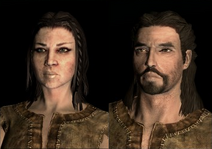
Bretons in Skyrim
- Main article: Breton
The Bretons are a race of humans who interbred with elves, mostly through Nordic concubines captured in the conquest of Skyrim during the First Era. Originally termed Manmer by the Aldmer, they were treated as lower-class citizens until the Nords took control of Skyrim back. At this point, the Manmer mingled in with the human population, and eventually migrated en masse to High Rock to become Bretons. The Bretons are considered primarily human, but inherit the magical affinity of their elvish blood.
Their appearance looks mostly of man, but they do appear, on average, to have more angled cheek, jaw, and chin bones not unlike the Altmer or Dunmer. They are slightly more frail in appearance than other "men", if they can be considered as such, just like the elven races. However, it is unknown which genes are more prominent and dominant in the Breton people, whether it be mer or man, however, given the more man-like appearance of Bretons, with the fact that most of Tamriel's populace consider them men, would lead one to assume that Bretons are more man than mer. Also, historically, the man/mer hybrids that were the Bretons' ancestors mingled with the human population after the humans regained control of Skyrim, meaning that they'd have more men than elven blood in them.
Falmer
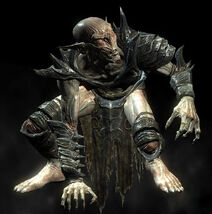
Falmer in Skyrim.
- Main article: Falmer
The Falmer, known as the Betrayed by the few remaining Snow Elves, are a race of Mer who have devolved into primitive creatures inhabiting the dark underground and remote areas of Skyrim. Centuries of life underground have caused the Falmer to adapt to their harsh environment. While physically similar to other Mer, the Falmer have changed noticeably. Their skin is a pale grayish tone and they move with a hunched posture.
Their most notable feature is their blindness; the Falmer lack eyes. However, their other senses have become extremely sensitive as a result, and unwary adventurers learn quickly that the Falmers' blindness is no handicap in combat.
Other Elven races
Maormer
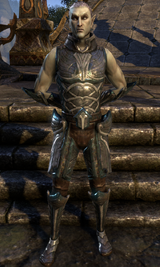
Ulondil, a Maormer.
- Main article: Maormer
The Maormer, or Sea Elves, also known as Tropical Elves,[7] are a race of exotic elves that inhabit the tropical land of Pyandonea, a group of islands well to the south the Summerset Isles. The most recent Pocket Guide to the Empire debunks a commonly-made claim that the Maormer were evicted by the Altmer. Instead, they broke off from the ancient Aldmer when their immortal wizard-king, Orgnum, began a revolt. What little is known about the Maormer includes their strange skin, rumored to have chameleon-like properties, and their practice of a style of snake magic.
Left-handed Elves
- Main article: Lefthanded Elf
Only briefly mentioned in a few in-game books, the Lefthanded Elves supposedly lived in the Redguard homeland of Yokuda. It is implied they were entirely destroyed by the Redguards in a war between the two. The rest of them died with Yokuda.[3]
Cantemiric Velothi
The Cantemiric Velothi were a race of Mer that inhabited Black Marsh. Not much is known about them at all. They are believed to be extinct due to the Knahaten Flu in 2E 560.[8]
See also
Sources
References
- ↑ The Real Barenziah, Book II
- ↑ The Imperial Library Races of Tamriel: Altmer (High Elf)
- ↑ 3.0 3.1 Varieties of Faith in the Empire
- ↑ Pocket Guide to the Empire, Third Edition: Summerset Isles
- ↑ Fragment: On Artaeum
- ↑ 2920, vol 04 - Rain's Hand
- ↑ Pocket Guide to the Empire, First Edition: Wild Regions
- ↑ Pocket Guide to the Empire, Third Edition: Black Marsh
| Races | |
|---|---|
| Humans | |
| Mer | |
| Beast | |
| Akaviri | |
| Et'Ada | |
